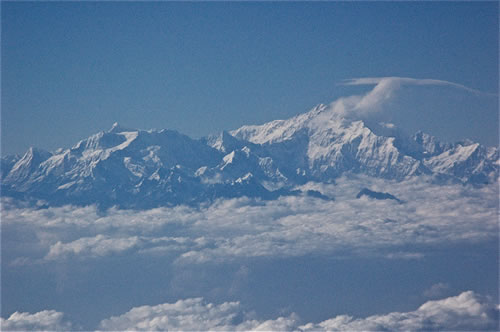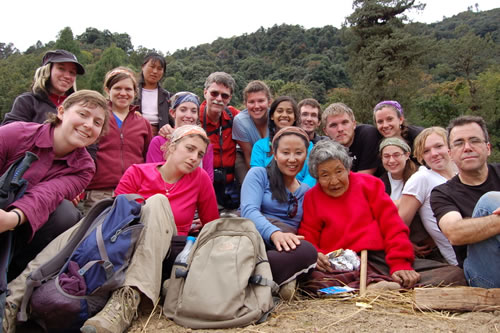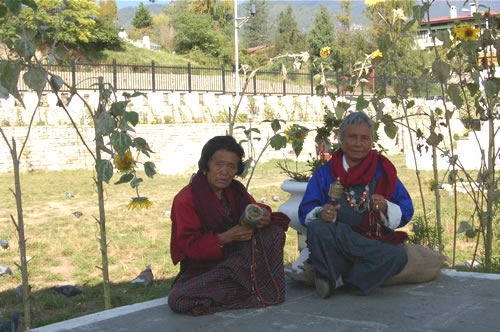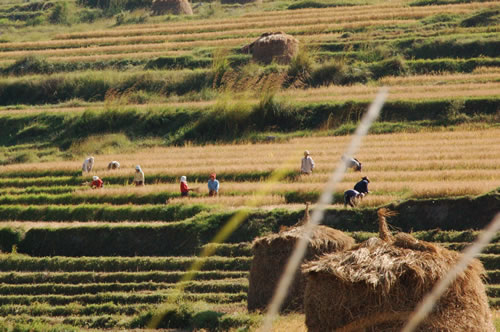Study and Travel Abroad in Bhutan
Experiential Learning with the Hiram College Study Abroad Program
Article and photos by Emma Strong

|
|
The Himalayas as seen from Bhutan.
|
Getting There
Our stomachs jumped with anticipation on the short flight from Bangkok, Thailand, to
Paro, Bhutan. After days of flying and a brief detour in Bangkok, we had nearly reached our destination. Soon, we began to see the outline of the Himalayan giants we would live in for the next month. Each second, they were closer to us, and we craned our necks to see over the airplane wings, trying to take in the endless horizon of hazy white pyramids. We were upon the mountain’s pointed snow-crusted tops in a few minutes, and I could not breathe. The mountains were layered on each other as far as we could see and stretched so high into the sky that the plane flew just above the rugged peaks.
We soon landed in Paro, the second largest city in Bhutan, in the only Bhutanese airport that supports Bhutan’s only two planes. As we stepped foot on the ground, I believe we each immediately felt a bond with the land. We saw an ant' s-eye view of the mountains we had just flown through. In every direction, mountains covered with tall, lean pine trees reached into the clouds. Our pilgrimage had begun.
A Brief History of Bhutan
Druk Yul, the "Kingdom of the Thunder Dragon," otherwise known to the Western world as Bhutan, is a small country the size of Switzerland with approximately 700,000 inhabitants. It is the last surviving Himalayan Buddhist country, and it sits above India and below China, with Nepal not too far off to the West. Until a few decades ago, Bhutan was a very isolated country, closed off from the rest of the world and uninterested in international politics. In 1971, Bhutan joined the United Nations and entered the world community. Hiram College offers countless study-abroad opportunities for students. Three and a half years ago, I sat in my Freshman writing course listening to our teacher’s assistant describe her magical, life-changing experience in Bhutan, a small country none of us had ever heard of. After seeing her photographs and listening to her stories, I knew I had to go to Bhutan. That opportunity presented itself during the fall of 2009.
Academic Preparation for Bhutan
Our small class of 12 students took two classes to prepare us for our trip, focusing on Responsible Economic Development and Buddhism. Everyone has a unique Bhutanese-style home and food. The houses are painted white or yellow, with intricate carvings and paintings decorating the windowsills and door frames. When I first saw a Bhutanese building, I felt like I had entered a fairy tale. Even the airport has this quaint look. The food is delicious. The Bhutanese specialty, Emadatse, consisting of locally grown and dried chilies and cheese, is usually too spicy for the average Western traveler. Yet, I immensely enjoyed the sweat I broke into after each bite.

|
|
Fellow students in Bhutan.
|
Today, forests are being destroyed faster than they can regenerate, yet Bhutan remains about 70% forested. Yet Bhutan is changing and is now subject to the onset of globalization. TVs, cell phones, and laptops have infiltrated the cities and are slowly reaching even more rural areas.
The Bhutanese Gross National Happiness (GNH) is their unique philosophy for achieving balance. Rather than determining the quality of life by quantifying monetary success, happiness is their most important indicator. GNH is all about achieving a balance between tradition and development, non-material and material. Bhutan is developing a GNH Index that will assist in attaining and quantifying gross national happiness. The index will incorporate many factors, including a healthy days per month indicator, an education level indicator, local air and water pollution indicators, a government performance index, etc.
Buddhism in Bhutan
Bhutan's national religion is a form of Tantric Buddhism. Yet, the religion practiced is genuinely a mixture of Buddhism and the Bon tradition, which existed in Bhutan before Buddhism arrived. Proponents of Buddhism, beginning in the 8th century, traveled to Bhutan and spent time taming and subduing the demons of the Bon religion, converting them into deities that support and protect Buddhism and the people of Bhutan. The Bhutanese still pay tribute to these deities who have a significant influence over the health of the people and the health of the land.
The ideals and values promoted by Gross National Happiness and Bhutanese Buddhism have combined to create a beautifully pristine and well-conserved environment. Much of the land in Bhutan is undisturbed or minimally disturbed by humans, for the landscape deities live in and are a part of the land. If they are angered, the people will feel their wrath, manifested in poor crops, inclement weather, and sickness. In some mountains, climbing is not allowed due to deaths previously caused by climbers who angered the mountain deities. The only billboards we saw were small hand-painted signs promoting environmental stewardship and safe sex.

|
|
A seated man and woman are reciting prayers. |
Intellectual Preparation and Spiritual Transformation
By taking the Responsible Economic Development and Buddhism courses in Bhutan via Hiram College and preparing intellectually for our pilgrimage by meditating and journaling daily, we were each adequately prepared for the mental and emotional transformations we all experienced in the enchanted land. We visited many kemphos, rinpoches, monks, and lamas — all Buddhist religious experts and teachers, as well as many temples and monasteries. We made journal entries as part of our coursework, contemplating development, happiness, enlightenment, engagement, and participation. We spent half our trip camping, living close to the land and the people.
These experiences and the fresh, clean, thin Himalayan air opened our minds to new experiences and interpretations of our surroundings and ourselves. I have never thought as clearly as I did in Bhutan. I remember every day’s activities on our trip, which ended almost three months ago. When I compare the mental clarity I experienced while in Bhutan to my American way of thinking and living, I can now barely remember what I ate for breakfast yesterday in the U.S.
The Basics of Visiting Bhutan
Everyone visiting Bhutan must pay a $200 daily tariff, including a tour guide (non-negotiable!), daily food, and lodging. Educational groups often receive discounts. Your tour guide will be the key to understanding Bhutanese history, culture, and current events. Mindup, our tour guide, and Lotay, our fearless driver, became our closest friends in Bhutan. Mindup leads a morning chant/prayer on the bus ride from each hotel to our next destination. We all closed our eyes and sang om mani padme hum. Mindup kept our journey lighthearted, teaching us archery and darts, the two most popular Bhutanese sports, and by playing Bhutanese pop music on the bus — which we grew to love.
The hotels in Bhutan are all beautiful, although you are bound to encounter a power outage at some point during your stay. But not to fear — there are always candles on every nightstand. We enjoyed an aromatic, flavorful buffet at every restaurant, hotel, and campsite with delicious meat, potato, vegetable, and curry dishes.
Camping and Trekking in Bhutan
You really must camp while visiting Bhutan. Camping was the most memorable aspect of my experience in Bhutan while studying abroad. Each night, we sat around a campfire, and some nights, we were joined by local Bhutanese who taught us Bhutanese songs and dances around the fire. Of course, they wanted to learn some American dances, and shamefully, all we could think of was the "Chicken Dance" and the "Hokie Pokie." We ended each night staring into the infinite sky, freckled with the brightest stars I have ever seen.
The biggest treat for the girls at one campsite was being driven up to a spring of holy water where we washed our hair, mostly with Dr. Bronner’s Castile Soap, so as not to pollute the water. In addition to simply camping, we spend five days trekking through the Himalayas. It was frigid but also illegal to have a fire on treks, so we retired to bed early, soon after the sun went down. We snuggled into our warm sleeping bags with five layers of clothing on our legs and upper body and hot water bottles at our feet.
We were greeted by “Tea, Coffee?” calls outside our tent each morning. A line of pack horses carried our bags, food, tents, and propane throughout the trek. On the fourth morning of our trek, we began hiking as usual. About an hour into the hike, we came across a line of horses coming the opposite way. We all jumped out of the way off the narrow trail to let the animals pass. Mindup laughed as he said, “Look, these horses do not have any packs.” We did not understand the joke until he told us they were our horses! They had been scared off in the evening by a herd of yaks that passed through our camp. They ran to their home at the end of the trek, and the horse riders with us did not realize it until the morning! Of course, the horses returned to collect our things and eventually passed us despite carrying our heavy belongings.
Trekking in Bhutan allows you to truly get a feel for the land. You will travel through densely wooded forests, high alpine landscapes, and mountain passes decorated with hundreds, if not thousands, of prayer flags.

|
|
An agricultural scene of locals while harvesting in fields of Bhutan.
|
The Bhutanese People
I have never met people as happy and friendly as the Bhutanese. English is Bhutan's educational language, allowing us to communicate with most people. Our professors arranged for us to meet with many Bhutanese, including GNH experts, critical religious figures, and Bhutanese environmentalists. Talk to as many people as you can in Bhutan. You will not have to make too great an effort since so many people will actively engage you in conversation, asking where you have been and what you have seen. You will learn the most through your interactions with the beautiful people of this magical land.
Advice When Visiting Bhutan
-
Try not to drink too much tea before going to sleep while trekking. It gets freezing at night, and 4 a.m. trips to the bathroom are unpleasant. You might want to bring a couple of extra rolls of toilet paper.
-
Bring a camera. You cannot take a bad photograph in Bhutan.
-
Buy a purifying water bottle before you set off on your trip. Although bottled water is usually readily available, these water bottles are handy on treks.
-
Research the temperatures if you will be camping or trekking. Make sure you get a sleeping bag that is warm enough! Buy a Gho or Kira (the traditional Bhutanese dress for men and women, respectively). Most Bhutanese still wear the national dress required in governmental buildings, temples, monasteries, and schools. Wear the traditional dress if you are in Bhutan during a festival. You will receive many compliments and may even feel like a Bhutanese for a short time. We received an invitation to be the Guests of Honor at a rural school’s Game Day. We all excitedly donned our colorful clothes and met many compliments from the local Bhutanese women, saying they had never seen such beautiful combinations of colors!
-
Although you may not be Buddhist and may not believe in Buddhist traditions, you should immerse yourself in Bhutanese culture as much as possible. We all got over our shyness and performed the usual prostrations in temples, putting our hands in a prayer position, reaching above our head, touching our forehead, touching our chest, dropping to our knees, and then bringing our hands and forehead to the ground. The Bhutanese encourage visitors, no matter their religious beliefs, to participate in Buddhist rituals. In temples, we silently prayed to end the suffering of all sentient beings. By actively participating in Bhutanese tradition, you become closer to understanding Bhutan, the Bhutanese, and their rich culture.
-
While driving, keep your eyes peeled for monkey’s jumping from tree to tree! Before you go, get to know Guru Rinpoche and Drukpa Kunley, two well-respected historical figures active in taming demons and promoting Buddhism. You will hear countless stories and many historical sites about these two figures.
-
Finally, it would be best if you tried to visit Chimi Lhakhang, a temple closely connected to Lama Drukpa Kunley, The Divine Madman. Here you will be bonked in the head with a Flaming Thunderbolt of Wisdom or a large wooden penis. Do not be alarmed; the penis symbol is revered in Bhutan!
To read lighthearted antidotes about Bhutan, including Flaming Thunderbolts of Wisdom, buy The Blessings of Bhutan, by Russ and Blyth Carpenter.
When visiting Bhutan, you must be open to everything you see and experience. Just try to soak it in sensitively. With the right attitude, Bhutan will transform you spiritually and heighten your awareness of the world.
Emma Strong is a senior Environmental Studies major at Hiram College. Emma has two minors; music (cello) and photography.
|
